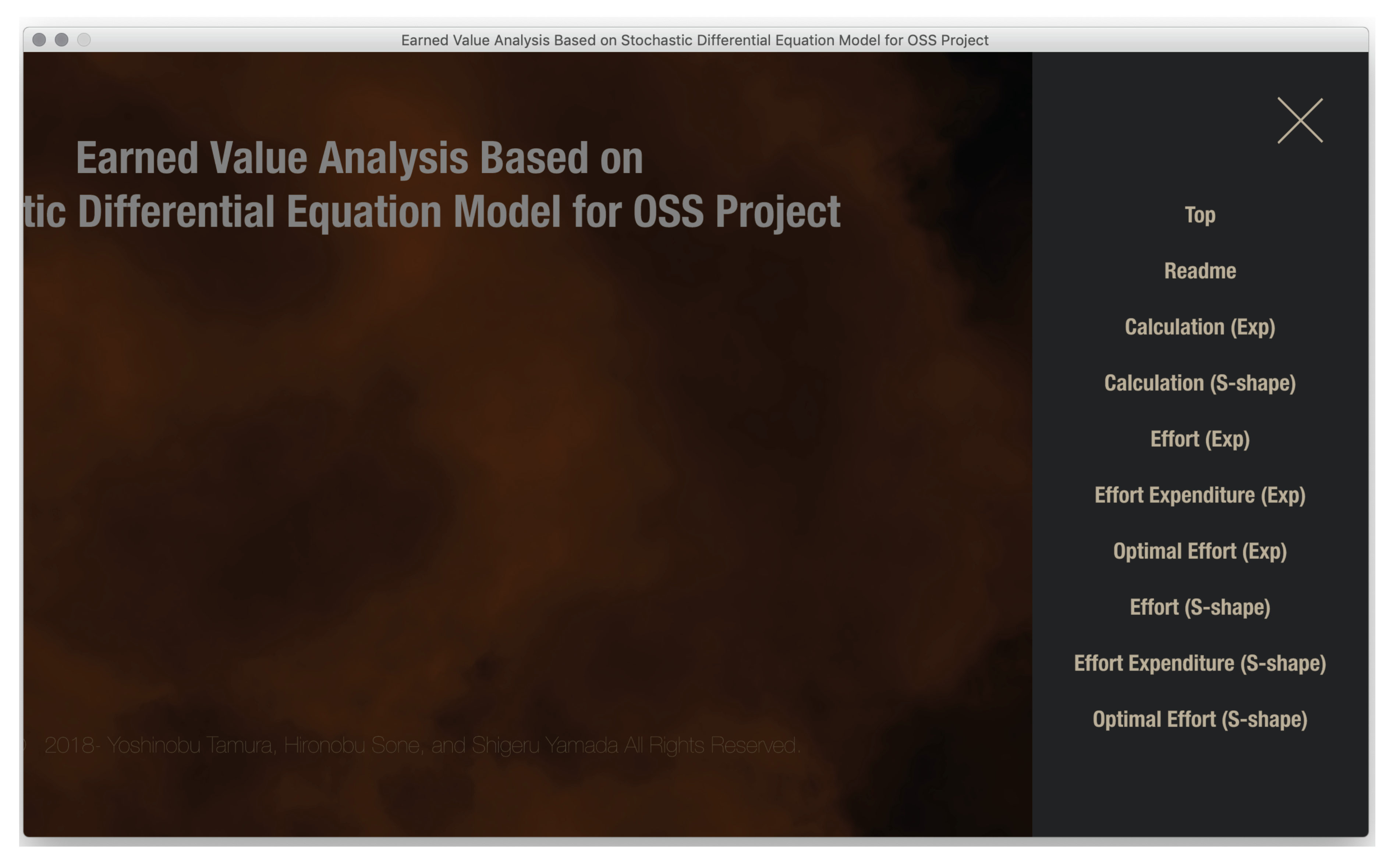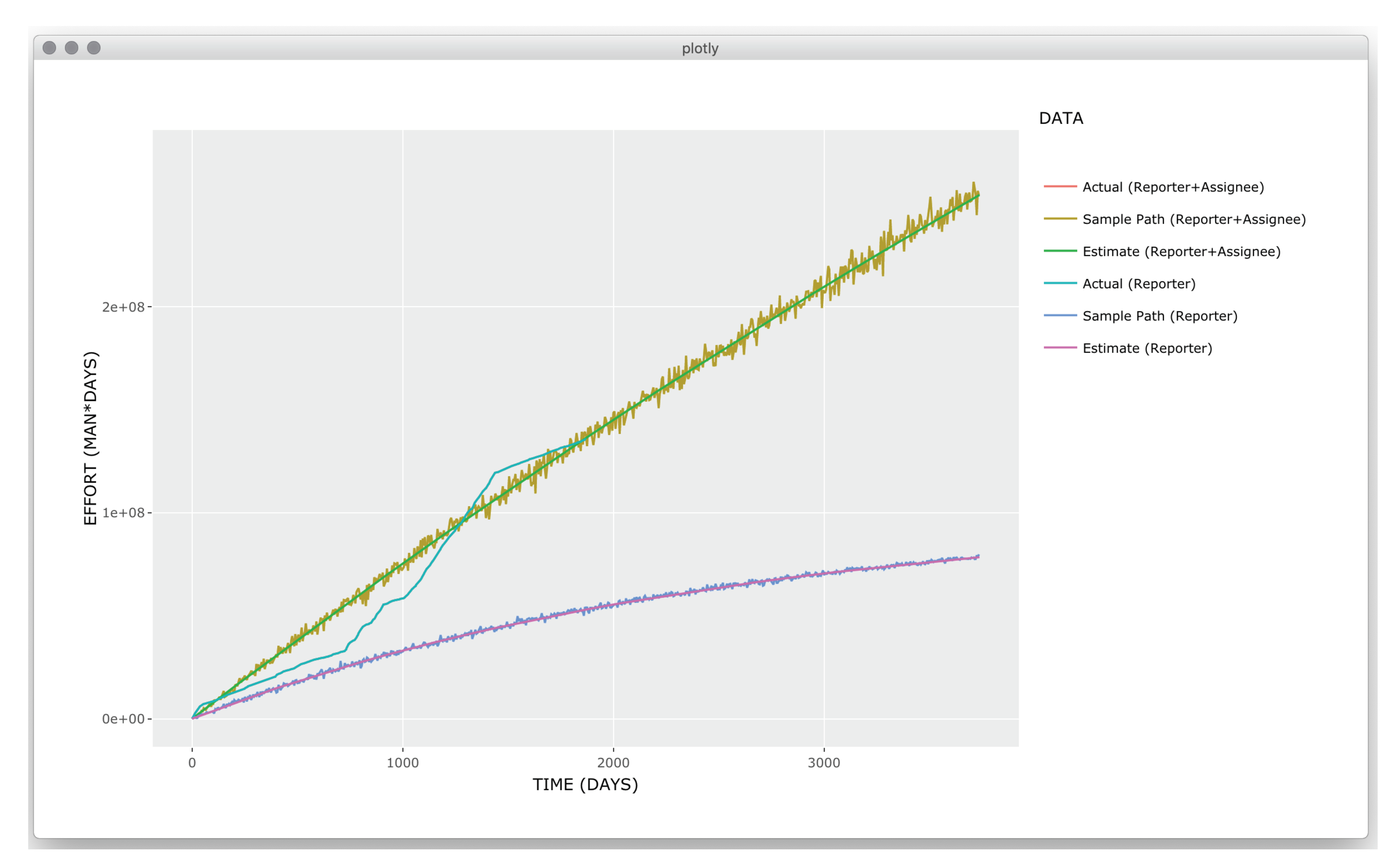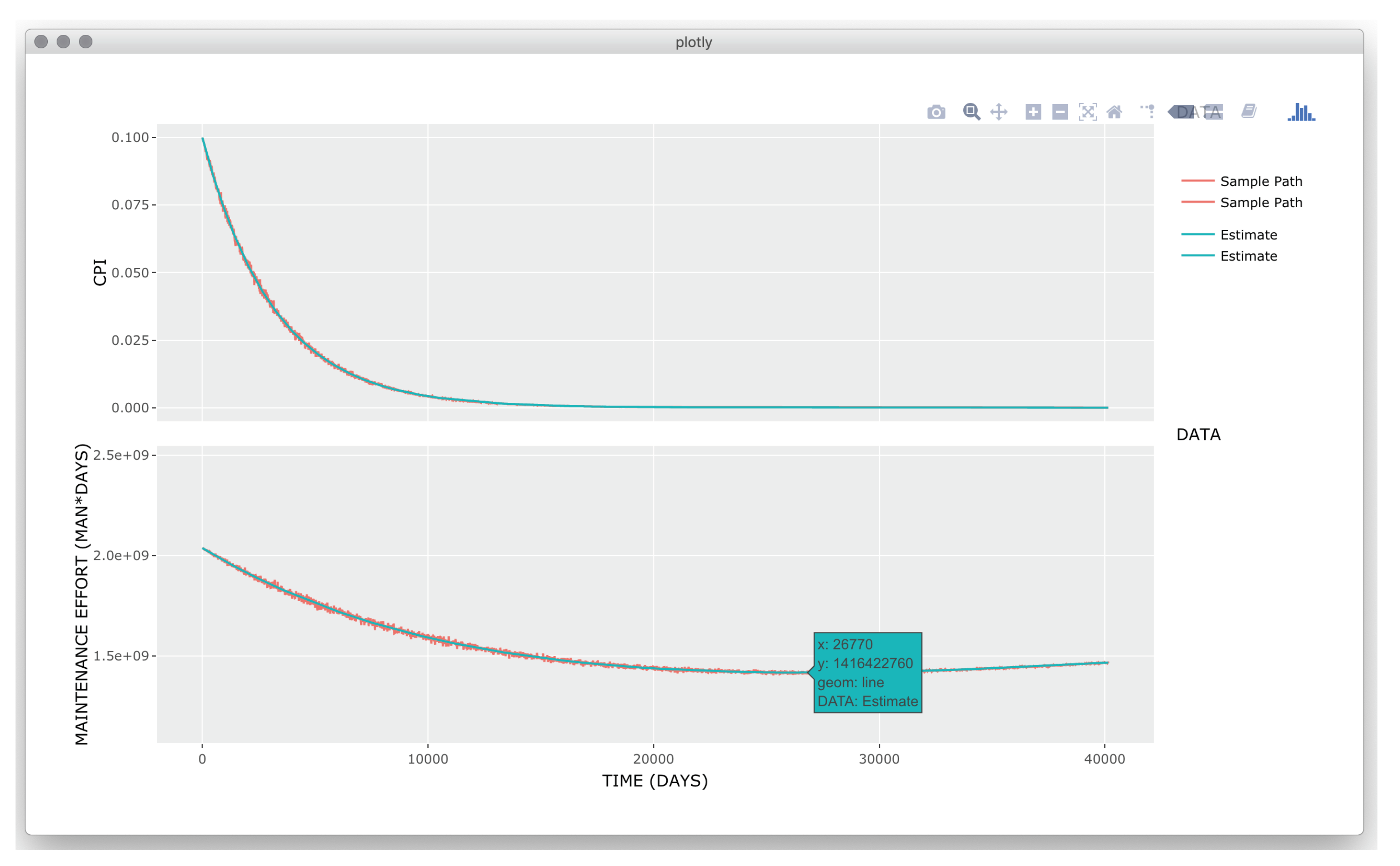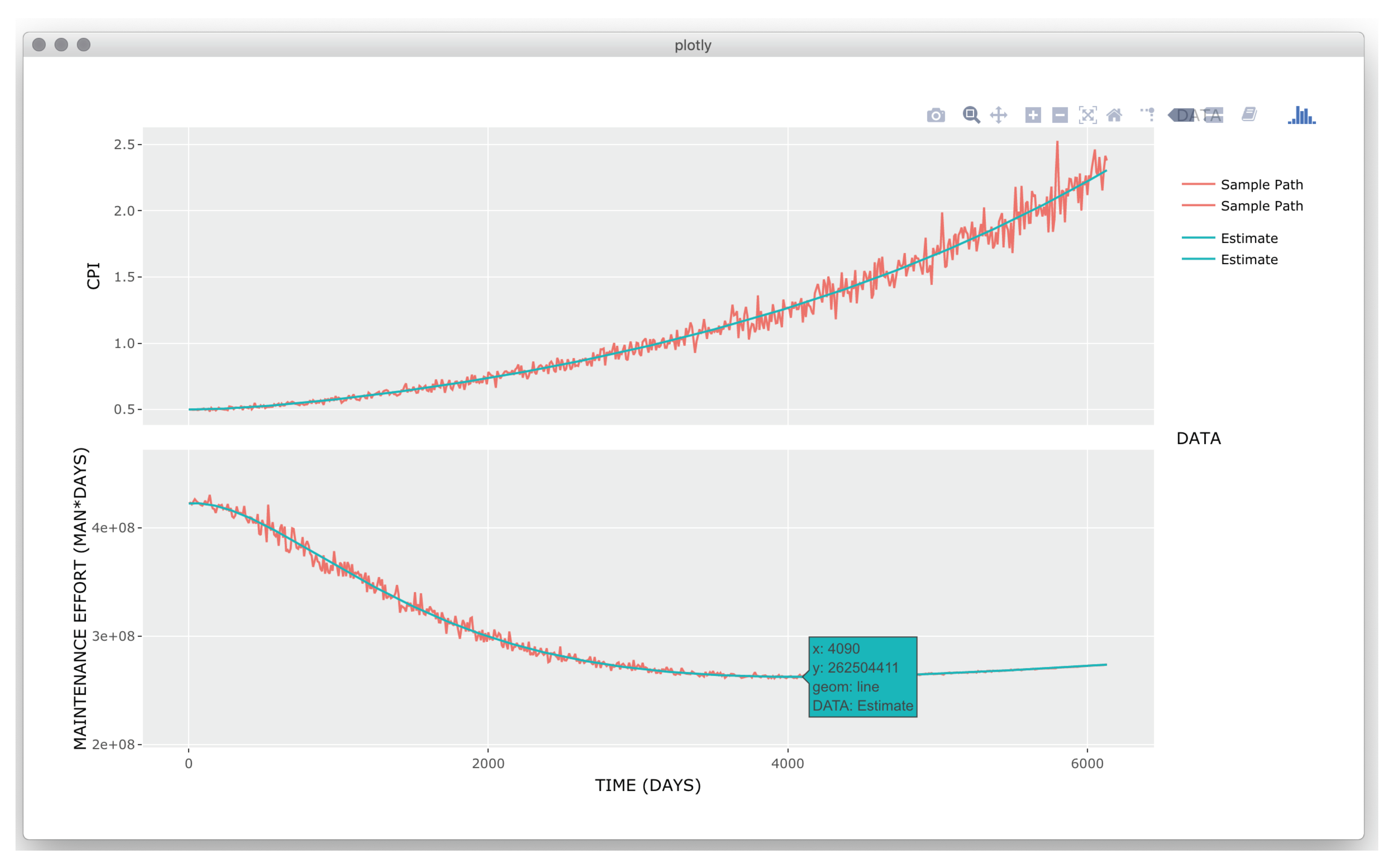OSS Project Stability Assessment Support Tool Considering EVM Based on Wiener Process Models
Abstract
:1. Introduction
2. Wiener Process Models for Effort Estimation
3. Assessment Measures for EVM
- ▸
- Actual Cost (AC): Cumulative maintenance effort up to operational time t considering the reporter and assignee.
- ▸
- Earned Value (EV): Cumulative maintenance effort up to operational time t considering the reporter.
- ▸
- Cost Variance (CV): Fixing effort required for OSS maintenance up to operational time t, and .
- ▸
- Cost Performance Index (CPI): and obtained from AC and EV.
- ▸
- Estimate at Completion (EAC): and obtained from AC, EV, CPI, and BAC.
- ▸
- Estimate to Completion (ETC): and obtained from AC, EV, CPI, BAC, and EAC.
- ▸
- Budget at Completion (BAC): Planned Value (PV) in the end point as the specified goal of OSS project.
4. Optimal Maintenance Time Based on Wiener Process Models Considering CPI as Requirement Specification
- :
- the importance rate of maintenance effort needed to operate OSS,
- :
- the operation effort per unit time during the operation,
- :
- the importance rate of maintenance effort after the upgrade task such as major version upgrade.
5. Framework of OSS Project Stability Support tool Considering EVM
- ▸
- This tool should be operated by clicking the mouse button and typing on the keyboard to input the data through GUI system. In particular, the user experience design is adopted as the important element of our tool.
- ▸
- Statistical computing R for statistical computing and ggplot2 library of R package should be implemented to the source program. This tool is developed as a stand–alone of multi–platform. Also, this tool operates as Web application via the Web server.
- ▸
- The method of maximum-likelihood is used as the estimation of unknown parameters in our model. Moreover, the optimum maintenance time is estimated by using the method of general–purpose optimization based on Nelder–Mead.
- ▸
- This tool treats the proposed effort estimation model based on stochastic differential equation, and illustrate the cumulative maintenance effort at arbitrary time t, the CPI, and the total software maintenance effort.
- ▸
- Visual Design
- ▸
- Information Architecture
- ▸
- Information
- ▸
- Structuring, Organization and Labeling
- ▸
- Finding and Managing
- ▸
- Interaction Design
- ▸
- Usability
- ▸
- Accessibility
- ▸
- Human-Computer Interaction
- This tool processes the data file in terms of the effort data in the OSS project.
- Using the effort data obtained from the actual OSS project, we analyze the data for input data.
- This tool estimates the unknown parameters included in our model. Then, the unknown parameters are estimated by using the method of maximum–likelihood.
- This tool illustrates the estimated cumulative maintenance effort, fixing effort required for OSS maintenance until the end of operation, total expected software maintenance effort, and CPI as EVM measures.
- We focus on the maintenance time based on Wiener process models considering CPI as requirement specification. In particular, the total software effort and the optimal software maintenance time minimizing the effort for our model are plotted in our tool.
6. Performance Illustrations Based on Developed Tool
7. Conclusions
Author Contributions
Funding
Acknowledgments
Conflicts of Interest
References
- Fleming, Q.E.; Koppelman, J.M. Earned Value Project Management, 4th ed.; PMI: Newton Square, PA, USA, 2010. [Google Scholar]
- Yamada, S.; Tamura, Y. OSS Reliability Measurement and Assessment; Springer International Publishing: Cham, Switzerland, 2016. [Google Scholar]
- Norris, J. Mission-critical development with open source software. IEEE Softw. Mag. 2004, 21, 42–49. [Google Scholar] [CrossRef]
- Zhou, Y.; Davis, J. OSS reliability model: An empirical approach. In Proceedings of the Fifth Workshop on OSS Engineering, St. Louis, MO, USA, 17 May 2005; pp. 67–72. [Google Scholar]
- Yamada, S. Software Reliability Modeling: Fundamentals and Applications; Springer: Tokyo, Japan; Heidelberg, Germany, 2014. [Google Scholar]
- Lyu, M.R. (Ed.) Handbook of Software Reliability Engineering; IEEE Computer Society Press: Los Alamitos, CA, USA, 1996. [Google Scholar]
- Musa, J.D.; Iannino, A.; Okumoto, K. Software Reliability: Measurement, Prediction, Application; McGraw-Hill: New York, NY, USA, 1987. [Google Scholar]
- Kapur, P.K.; Pham, H.; Gupta, A.; Jha, P.C. Software Reliability Assessment with OR Applications; Springer: London, UK, 2011. [Google Scholar]
- Li, X.; Li, Y.F.; Xie, M.; Ng, S.H. Reliability analysis and optimal version-updating for open source software. J. Inf. Softw. Technol. 2011, 53, 929–936. [Google Scholar] [CrossRef]
- Ullah, N.; Morisio, M.; Vetro, A. A comparative analysis of software reliability growth models using defects data of closed and open source software. In Proceedings of the 35th IEEE Software Engineering Workshop, Crete, Greece, 12–13 October 2012; pp. 187–192. [Google Scholar]
- Cotroneo, D.; Grottke, M.; Natella, R.; Pietrantuono, R.; Trivedi, K.S. Fault triggers in open-source software: An experience report. In Proceedings of the 24th IEEE International Symposium on Software Reliability Engineering, Pasadena, CA, USA, 4–7 November 2013; pp. 178–187. [Google Scholar]
- Park, J.; Yu, H.C.; Lee, E.Y. Resource allocation techniques based on availability and movement reliability for mobile cloud computing. In Distributed Computing and Internet Technology; Lecture Notes in Computer Science; Springer: Berlin, Germany, 2012; Volume 7154, pp. 263–264. [Google Scholar]
- Suo, H.; Liu, Z.; Wan, J.; Zhou, K. Security and privacy in mobile cloud computing. In Proceedings of the 9th International Wireless Communications and Mobile Computing Conference, Cagliari, Italy, 1–5 July 2013; pp. 655–659. [Google Scholar]
- Khalifa, A.; Eltoweissy, M. Collaborative autonomic resource management system for mobile cloud computing. In Proceedings of the Fourth International Conference on Cloud Computing, GRIDs, and Virtualization, Valencia, Spain, 27 May–1 June 2013; pp. 115–121. [Google Scholar]
- Gabner, R.; Schwefel, H.P.; Hummel, K.A.; Haring, G. Optimal model-based policies for component migration of mobile cloud services. In Proceedings of the 10th IEEE International Symposium on Network Computing and Applications, Cambridge, MA, USA, 25–27 August 2011; pp. 195–202. [Google Scholar]
- Park, N. Secure data access control scheme using type-based re-encryption in cloud environment. In Semantic Methods for Knowledge Management and Communication; Studies in Computational Intelligence; Springer: Berlin, Germany, 2011; Volume 381, pp. 319–327. [Google Scholar]
- Wong, E. Stochastic Processes in Information and Systems; McGraw-Hill: New York, NY, USA, 1971. [Google Scholar]
- Arnold, L. Stochastic Differential Equations-Theory and Applications; John Wiley & Sons: New York, NY, USA, 1971. [Google Scholar]
- Yamada, S.; Kimura, M.; Tanaka, H.; Osaki, S. Software reliability measurement and assessment with stochastic differential equations. IEICE Trans. Fundam. 1994, E77-A, 109–116. [Google Scholar]
- Hanna, R.A. Earned Value Management Software Projects. In Proceedings of the 2009 Third IEEE International Conference on Space Mission Challenges for Information Technology, Washington, DC, USA, 19–23 July 2009; pp. 297–304. [Google Scholar]
- Tamura, Y.; Sone, H.; Yamada, S. Earned value analysis and effort optimization based on Wiener process model for OSS project. In Proceedings of the 2018 Asia-Pacific International Symposium on Advanced Reliability and Maintenance Modeling (APARM 2018) and 2018 International Conference on Quality, Reliability, Risk, Maintenance, and Safety Engineering (QR2MSE 2018), Qingdao, China, 21–24 August 2018; pp. 373–378. [Google Scholar]
- Yamada, S.; Osaki, S. Cost-reliability optimal software release policies for software systems. IEEE Trans. Reliab. 1985, R-34, 422–424. [Google Scholar] [CrossRef]
- Yamada, S.; Osaki, S. Optimal software release policies with simultaneous cost and reliability requirements. Eur. J. Oper. Res 1987, 31, 46–51. [Google Scholar] [CrossRef]
- The Apache Software Foundation. The Apache HTTP Server Project. Available online: http://httpd.apache.org/ (accessed on 1 January 2019).








© 2019 by the authors. Licensee MDPI, Basel, Switzerland. This article is an open access article distributed under the terms and conditions of the Creative Commons Attribution (CC BY) license (http://creativecommons.org/licenses/by/4.0/).
Share and Cite
Tamura, Y.; Sone, H.; Yamada, S. OSS Project Stability Assessment Support Tool Considering EVM Based on Wiener Process Models. Appl. Syst. Innov. 2019, 2, 1. https://doi.org/10.3390/asi2010001
Tamura Y, Sone H, Yamada S. OSS Project Stability Assessment Support Tool Considering EVM Based on Wiener Process Models. Applied System Innovation. 2019; 2(1):1. https://doi.org/10.3390/asi2010001
Chicago/Turabian StyleTamura, Yoshinobu, Hironobu Sone, and Shigeru Yamada. 2019. "OSS Project Stability Assessment Support Tool Considering EVM Based on Wiener Process Models" Applied System Innovation 2, no. 1: 1. https://doi.org/10.3390/asi2010001
APA StyleTamura, Y., Sone, H., & Yamada, S. (2019). OSS Project Stability Assessment Support Tool Considering EVM Based on Wiener Process Models. Applied System Innovation, 2(1), 1. https://doi.org/10.3390/asi2010001




